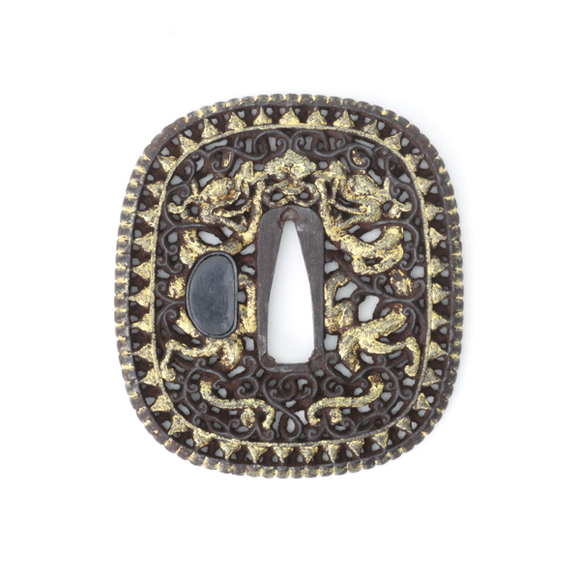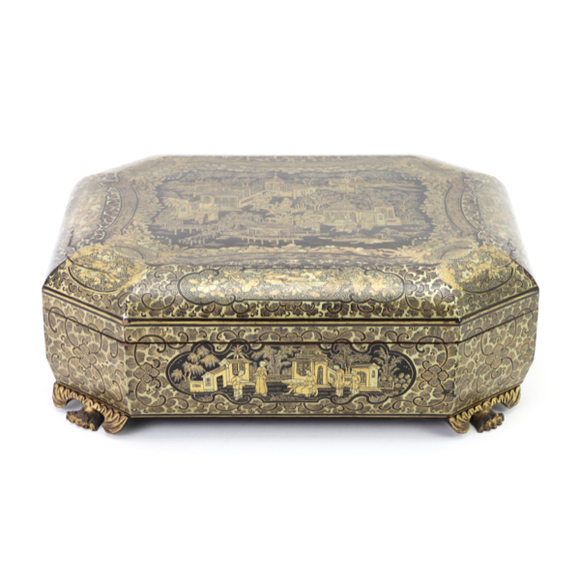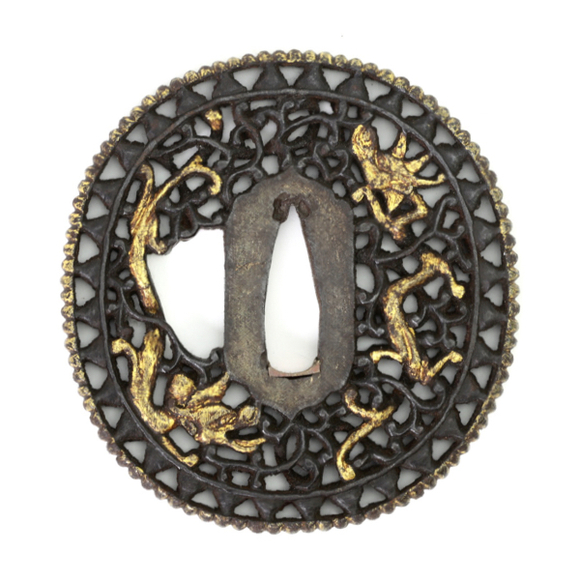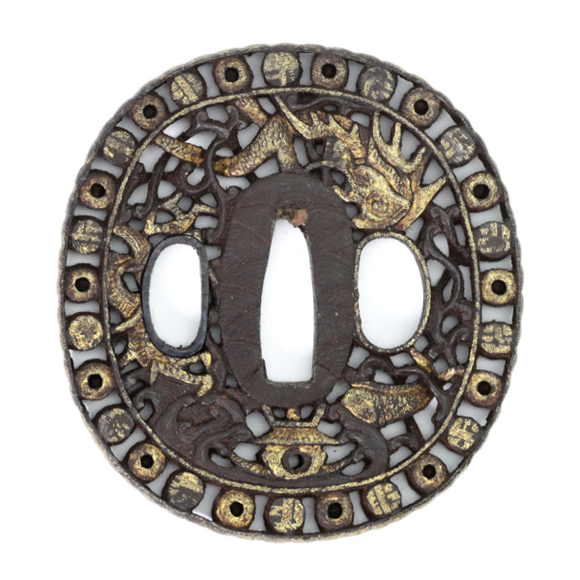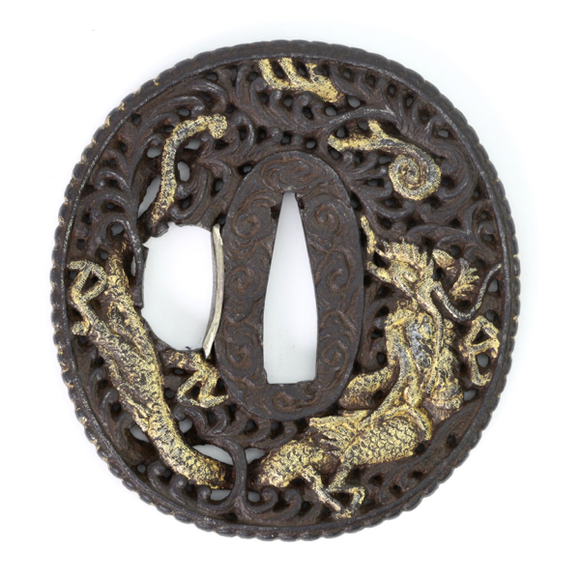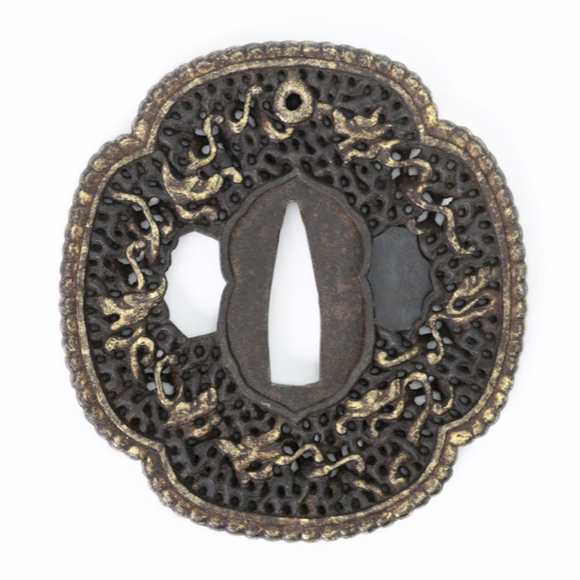Of pierced iron, elaborately cut with lotus petal border.

68.7 cm
51.4 cm
Base 4.8 mm
Middle 4 mm
5 cm from tip 3 mm
Base 33 mm
Middle 30 mm
5 cm from tip 24 mm
517 grams
16.5 cm
(from hilt side of guard)
Iron, steel, wood, copper, báitóng (白銅), cotton
Longquan, Zhejiang
Southern China
Circa 1875-1900
From a European private collection
Description
A rare short sword (duǎnjiàn (短劍)) made in the famous sword production center of Longquan. It features a relatively wide blade with a central ridge. It has the seven stars of the Big Dipper inlaid on one side. For the significance of the Big Dipper in Daoism, see my article Běidǒu (北斗).
The other side features elaborate brass inlays in the form of a dragon and phoenix, a smaller Big Dipper near the point, and inlaid characters at the base of the blade.

龍泉
Lóngquán
劍万
Jiàn Wàn
"Longquan sword 10.000"
Wàn (万) "10.000" here refers to the shop named Wàn Zì Hao (万字号), literally "10.000 mark brand". It was founded in the early Guangxu period (1870s-80s) by Zhōu Guóhuá (周国华), after completing his study under the lineage holder of the Qiān Zì Hao shop.
For more information on Longquan makers, see my article: Lóngquán (龍泉)
Mounts
The sword comes with a hardwood grip and scabbard and a full set of typical Longquan mounts of the period, made of báitóng (白銅) with stylistic cutouts. Stylistically it is very similar to a sword made by the Qiān Zì Hao shop that I sold earlier, showing great consistency between master and student. See comparable examples below.
Condition
Some pitting to the blade, minor edge damage, a dent in the guard, a crack in the scabbard. See photos. One plate of the pommel was lost and was invisibly restored with the same material by Gotscha Lagidse. Otherwise in very good shape.
Comparable examples
For a full list of other Lóngquán sword I encounted, see my glossary article Lóngquán.
A rather similar shortsword by Qian Zi Hao, teacher of the founder of Wan Zi Hao, sold by Mandarin Mansion earlier:

A shortsword made by Qiān Zì Hao of Longquan.
Sold by Mandarin Mansion in 2022.
Use of "fancy shortswords"
I can't write about a fancy looking shortsword without bringing up the following, most interesting passage that refers to their possible use. Adventurer William Mesny, who eventually became a general in the Qing army, provides us with a rare account of traveling duelers:
"Fu Hu Chün 副護軍. Second battalion of guards. This is an extra battalion of guards, all picked young Kuei-chou men, between twenty or thirty years old, real swashbucklers, good looking and lavishly decorated with scars obtained in battle or duel. Every other man of them has a Yüeh Ching, moon instrument (a sort of short handled like discular guitar) slung to his back and carries a dagger as well as a fancy shortsword at his side. These are duelists by profession apparently and also troubadourists of the mountains too. Each warrior has his fancy girl at home and an extra one or two in every town. Duelling and love-song singing is a sort of pastime with them when not engaged in the stern realities of actual warfare.
They fight duels with each other sometimes as soon as they are cured from former wounds as acts of revenge, called Pao Chou (報仇), and they sometimes take up each other's cause, as for instance in case of wrongful treatment of the weak and defenseless by the strong, or using might against right; this kind of protection or defense is called Pao Pu Ping (抱不平), and is much in vogue in Kuei-chou at this present time. Many young men learn the use of weapons and take a great deal of physical exercise so as to accustom themselves to hardships with a view of avenging some one's wrongs. Some or many such are now enrolled in the ranks of our Fu Hu Chün, the second battalion of General Liu's guards. Nearly all these young men have a servant to do their camp work for them, to act as squires to knights of olden times. Soldiers of the guard battalions all hare the characters Ch'in Ping 親兵 Body-Guard, Garde du Corp, sew on front and back of their uniforms, whilst ordinary soldiers have the word Yung 勇, which means Brave of Knight. It is usually from the ranks of distinguished Yung the Ch'in ping are recruited; all-being picked men as often for their good looks as their martial qualities, as may be easily perceived on parade." 4
-William Mesny, 18 March 1905.
The above narrative of traveling, dueling heroes with guitar-like instruments almost reminds of Zorro of Western pop culture. It shows that there was a fairly large, unregulated market for "fancy shortswords" that were actually put to use. The fact that they had these instruments and even servants shows that they were not poor, which explains the quality of some of these that exceed militia- and military-grade weapons of the same period.
Conclusion
It is quite rare to find a Chinese sword of which the maker is known, but the overall style of this sword and the mark wàn (万), in this case, help to positively attribute it to Zhōu Guóhuá's Wàn Zì Hao shop in Longquan.
Notes
1. See Alex Huangfu; Iron and Steel Swords of China. (皇甫江; 中国刀剑). Jinan, Tomorrow Publishing House, 2007. Page 225.
2. See the first image in an article by Ben Judkins; Through a Lens Darkly (24): Captured Chinese Swords and Traditional Weapons. Published online, 2014.
3. Mesny's Miscellany, 18 March 1905.











A nice example with unusually fine lacquerwork and a monogram in the lid.
Canton work for the Japanese market, with 28 metal balls in separate compartments.

